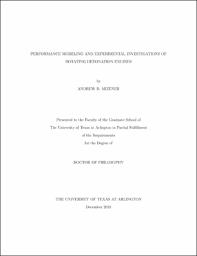
ATTENTION: The works hosted here are being migrated to a new repository that will consolidate resources, improve discoverability, and better show UTA's research impact on the global community. We will update authors as the migration progresses. Please see MavMatrix for more information.
Show simple item record
| dc.contributor.advisor | Lu, Frank | |
| dc.creator | Mizener, Andrew Ryan | |
| dc.date.accessioned | 2019-02-26T22:10:43Z | |
| dc.date.available | 2019-02-26T22:10:43Z | |
| dc.date.created | 2018-12 | |
| dc.date.issued | 2018-12-13 | |
| dc.date.submitted | December 2018 | |
| dc.identifier.uri | http://hdl.handle.net/10106/27779 | |
| dc.description.abstract | The rotating detonation engine (RDE) is a promising propulsion concept that has the potential to offer increased thermodynamic performance in a compact package with no moving parts. A series of analytical and experimental investigations was carried out on RDEs with the joint goal of investigating swirl, torque, and a range of other design parameters of interest. The model and experimental facility were then applied to related problems with the goal of advancing the understanding of RDE applications.
A flexible, low-order, semi-empirical model for a rotating detonation engine was presented. The model was formulated to be able to run broad parametric analyses more efficiently than numerical modeling. The presence of swirl at the exit plane of RDEs is still debated, so the model was formulated to leave open this possibility. Parametric analysis was conducted to determine the effect of a range of engine design parameters on performance. Exit swirl and torque were shown to be small but not uniquely zero.
The model was combined with a waverider forebody model. Together, these were used to conduct parametric analysis of the sensitivity of integrated performance to freestream, waverider forebody, and RDE design parameters. Practical limitations on the Mach number of detonation engines operating in supersonic flows were presented and discussed. Peak performance was seen at the point of maximum forebody pressure recovery. Thrust and torque were shown to be sensitive to body shape and freestream parameters, while specific impulse and thrust-specific fuel consumption were not.
The design of a rotating detonation engine and experimental test facility were presented and discussed. The facility was designed and instrumented to allow the measurement of resultant torque on the engine as well as take thrust and pressure readings. A series of tests was conducted using the engine, with no steadily-propagating detonation waves detected. Pressure, torque, thrust, and frequency data were presented and discussed. A high-speed camera was used to visualize the exhaust plume and the flame structure inside the annulus, which similarly failed to detect a detonation wave. The camera was then used to conduct high-speed visualizations of the ignition process inside the engine for both spark plug and predetonator igniters. Both methods showed the creation of two counter-rotating detonation waves which intersected and canceled each other out on the far side of the annulus. Pressure waves were observed to continue to rotate for several periods before dying out. The qualitative observations from the visualizations were supported by the pressure data. Detailed visualizations were performed to quantitatively investigate the propagation of the initial combustion front around the annulus for varying degrees of injector swirl. Predetonator ignition was observed to directly initiate a detonation, whereas deflagration-to-detonation transition was observed for spark plug ignition. Injector swirl promoted transition in combustion waves propagating into the swirl and depressed it in waves propagating with the swirl. Overdriven detonations were observed for both ignition methods. A discussion of the possible causes for the failure to sustain a detonation wave was presented and discussed. | |
| dc.format.mimetype | application/pdf | |
| dc.language.iso | en_US | |
| dc.subject | Detonation | |
| dc.subject | Rotating detonation engine | |
| dc.subject | Rotating detonation | |
| dc.subject | Propulsion | |
| dc.title | Performance Modeling and Experimental Investigations of Rotating Detonation Engines | |
| dc.type | Thesis | |
| dc.degree.department | Mechanical and Aerospace Engineering | |
| dc.degree.name | Doctor of Philosophy in Aerospace Engineering | |
| dc.date.updated | 2019-02-26T22:10:44Z | |
| thesis.degree.department | Mechanical and Aerospace Engineering | |
| thesis.degree.grantor | The University of Texas at Arlington | |
| thesis.degree.level | Doctoral | |
| thesis.degree.name | Doctor of Philosophy in Aerospace Engineering | |
| dc.type.material | text | |
| dc.creator.orcid | 0000-0003-2659-580X | |
Files in this item
- Name:
- MIZENER-DISSERTATION-2018.pdf
- Size:
- 33.98Mb
- Format:
- PDF
This item appears in the following Collection(s)
Show simple item record


